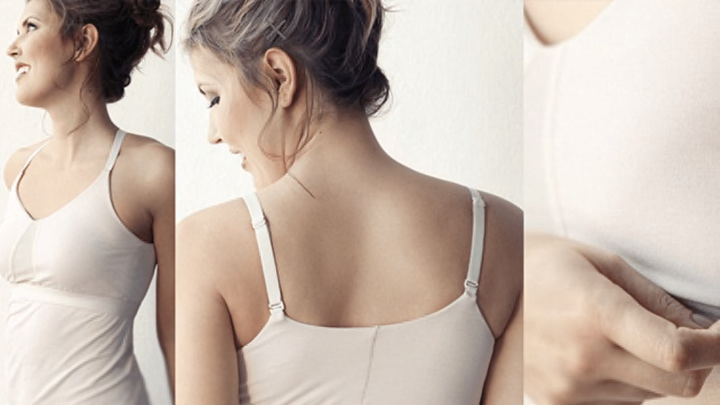Every year, approximately 250,000 American women are diagnosed with breast cancer. About half of those will need radiation treatment as part of their therapy to prevent recurrence of their cancer. While many women accept that temporary pain and discomfort from surgery and side effects are a part of the process, one radiation oncologist for Kaiser Permanente, Katie Deming of Portland, Oregon, was determined to make their experience less painful and contribute to their positive self-image along the way.
Over six years, through much trial and error, Deming designed and patented a bra and camisole specifically crafted to ease one of the physical agonies of radiation treatment: hypersensitivity.
"When I was in training as a resident, I didn't think much about telling my patients what to wear," Deming tells mental_floss. "The attending doctors who taught me—most were male." In fact, only one-third of the radiation oncologists in the U.S. are female. "My attending just told me to tell women not to wear a bra [during radiation treatment]," she recalls.
Deming found out quickly that she would have to amend her suggestions to her patients due to the extreme side-effects of radiation. "Radiation causes swelling in the breast by stimulating blood flow to the area, so it feels swollen, and like a bad sunburn," she says. "The brushing of even a soft cotton T-shirt against the breast, against irradiated skin, is excruciating."
Radiation treatment generally lasts anywhere from three to six weeks, but many patients say the hypersensitivity of their skin lasts much longer. "The time the skin is really irritated can be from two to four weeks, but some women feel their skin is just more sensitive after, and a lot of women feel their normal bras are irritating and more tender to fabric indefinitely," she says.
For years, Deming had been coming up with creative ways to help her patients find relief, such as to cut out a soft cotton T-shirt and put it inside a bra, or wear a camisole with a shelf bra inside out. But those improvisations were insufficient. "I felt it was crazy that every day I have to say this because products aren't available," she says.
While there is an existing market of post-operative bras for women undergoing breast cancer treatment, they are not ideal for radiation patients. Deming tested a selection of them out herself, acting as a patient in the special section for breast cancer at a big-name department store, and she was unimpressed with what she found.
"I realized the options women have are terrible," she says. "First, you walk through the beautiful lingerie section—and you don't get to wear any of those things. They bring you these medical-appearing bras in packages that are hideous. All these bras had seams, rubbed under the arms, elastic against the skin, which are wrong for patients to wear."
Deming knew nothing about apparel design or manufacturing when she decided to create her own garments, so set out to learn what she could. Six years (and more than $55,000 of her own money) later, with several setbacks along the way, Deming has three products she's launching online this May: a radiation-friendly camisole and two bras that will sell under the brand name MakeMerry.
The camisole has a built-in bra, while the two bras are designed for small-to-average sized women and larger-breasted women, respectively. All are made from spandex and modal, a hypersoft, jersey-like fiber derived from beech trees that gets softer with each washing. All points of contact between each garment and the skin have been considered in the design. All seams and elastic are hidden away from skin, and the bras are cut low in front to take into consideration common incision sites.
One of Deming's patients, Sharon Kim-Geib of Portland, an apparel sourcing agent who finds manufacturers for companies, played a key role in getting Deming's garments into the marketpace—and also became the first test subject of Deming's sample product.
In 2014 Kim-Geib was diagnosed with ductal carcinoma in situ (DCIS), a breast cancer in the milk duct. She wound up having two lumpectomies plus radiation. Diagnosis, surgery, and radiation took an emotional toll on her. "My two lumpectomies really made [my breast] disfigured and kind of ruined the shape. It made me feel not attractive anymore. I lost some confidence," she tells mental_floss. Shopping for a bra to wear during treatment was frustrating. "I visited a breast cancer center where they sell a lot of the bras for breast cancer, but theirs [were] so lousy," she said. For one thing, the seams and elastic were a torment to her skin.
When she tried on Deming's sample garment, Kim-Geib says, she noticed "a big-time difference"—particularly that it was soft and comfortable enough to be worn at any time. "I love the prettiness, too," she says.
Kim-Geib connected Deming with Dana Donofree, creator of Ana Ono intimates, which are designed for women who have had surgery for breast cancer and whose bodies may no longer fit into traditional bras and lingerie. Donofree is a breast cancer survivor herself who underwent both bilaterial mastectomy and reconstructive surgery.
Deming decided to license her products to Donofree under the Ana Ono line because "we both have very similar visions," she says. "It's not worth producing anything if it doesn't look beautiful, serve the needs women have, and make them feel normal that they are buying something beautiful. In fact, I'd argue that if you have cancer, you deserve something even better."
Of the name MakeMerry, she says, "This is a product born out of love to make the women I serve feel better, and something that I hope brings happiness into these women's lives."
